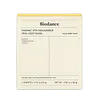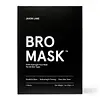What's inside
What's inside
 Key Ingredients
Key Ingredients

 Benefits
Benefits

 Concerns
Concerns

 Ingredients Side-by-side
Ingredients Side-by-side

Water
Skin ConditioningAnanas Sativus Fruit Water
Skin ConditioningGlycerin
HumectantAcrylates Copolymer
Niacinamide
Smoothing1,2-Hexanediol
Skin ConditioningCeratonia Siliqua Gum
EmollientBetaine
HumectantChondrus Crispus
MaskingPolyglyceryl-10 Laurate
Skin ConditioningPotassium Chloride
Sucrose
HumectantPolyglyceryl-2 Triisostearate
EmulsifyingAllantoin
Skin ConditioningAgar
MaskingCellulose Gum
Emulsion StabilisingEthylhexylglycerin
Skin ConditioningButylene Glycol
HumectantAdenosine
Skin ConditioningPyrus Communis Fruit Extract
Skin ConditioningSclerotium Gum
Emulsion StabilisingDisodium EDTA
Rosa Damascena Flower Water
MaskingMelia Azadirachta Leaf Extract
Skin ConditioningMelia Azadirachta Flower Extract
Skin ConditioningIris Florentina Root Extract
MaskingAnanas Sativus Fruit Extract
Skin ConditioningHippophae Rhamnoides Oil
EmollientCucumis Melo Fruit Extract
Skin ConditioningCurcuma Longa Root Extract
MaskingHedera Helix Leaf/Stem Extract
AntimicrobialOcimum Sanctum Leaf Extract
Skin ConditioningCorallina Officinalis Extract
Skin ConditioningTocopherol
AntioxidantSodium Hyaluronate
HumectantHydrolyzed Hyaluronic Acid
HumectantGluconolactone
Skin ConditioningBoron Nitride
AbsorbentCaprylyl Glycol
EmollientHydroxypropyltrimonium Hyaluronate
Glutathione
Sodium Acetylated Hyaluronate
HumectantHyaluronic Acid
HumectantHydrolyzed Sodium Hyaluronate
Skin ConditioningSodium Hyaluronate Crosspolymer
HumectantPotassium Hyaluronate
Skin ConditioningWater, Ananas Sativus Fruit Water, Glycerin, Acrylates Copolymer, Niacinamide, 1,2-Hexanediol, Ceratonia Siliqua Gum, Betaine, Chondrus Crispus, Polyglyceryl-10 Laurate, Potassium Chloride, Sucrose, Polyglyceryl-2 Triisostearate, Allantoin, Agar, Cellulose Gum, Ethylhexylglycerin, Butylene Glycol, Adenosine, Pyrus Communis Fruit Extract, Sclerotium Gum, Disodium EDTA, Rosa Damascena Flower Water, Melia Azadirachta Leaf Extract, Melia Azadirachta Flower Extract, Iris Florentina Root Extract, Ananas Sativus Fruit Extract, Hippophae Rhamnoides Oil, Cucumis Melo Fruit Extract, Curcuma Longa Root Extract, Hedera Helix Leaf/Stem Extract, Ocimum Sanctum Leaf Extract, Corallina Officinalis Extract, Tocopherol, Sodium Hyaluronate, Hydrolyzed Hyaluronic Acid, Gluconolactone, Boron Nitride, Caprylyl Glycol, Hydroxypropyltrimonium Hyaluronate, Glutathione, Sodium Acetylated Hyaluronate, Hyaluronic Acid, Hydrolyzed Sodium Hyaluronate, Sodium Hyaluronate Crosspolymer, Potassium Hyaluronate
Water
Skin ConditioningGlycerin
HumectantMethylpropanediol
SolventNiacinamide
SmoothingCeratonia Siliqua Gum
EmollientChondrus Crispus Extract
Skin ConditioningButylene Glycol
HumectantCellulose Gum
Emulsion StabilisingDipropylene Glycol
HumectantHydroxyacetophenone
Antioxidant1,2-Hexanediol
Skin ConditioningCaprylyl Glycol
EmollientSodium Polyacrylate
AbsorbentZingiber Officinale Root Extract
MaskingDisodium EDTA
Polyglyceryl-10 Laurate
Skin ConditioningXanthan Gum
EmulsifyingHydrogenated Polydecene
EmollientAdenosine
Skin ConditioningEthylhexylglycerin
Skin ConditioningPotassium Chloride
Sodium Hyaluronate
HumectantSodium Citrate
BufferingCitric Acid
BufferingDextrin
AbsorbentTrideceth-6
EmulsifyingCamellia Sinensis Leaf Extract
AntimicrobialCoptis Japonica Root Extract
Skin ConditioningDipotassium Glycyrrhizate
HumectantSchisandra Chinensis Fruit Extract
Skin ConditioningHydrolyzed Collagen
EmollientTocopherol
AntioxidantCopper Tripeptide-1
Skin ConditioningDipeptide-2
Skin ConditioningOligopeptide-1
Skin ConditioningPalmitoyl Pentapeptide-4
Skin ConditioningTripeptide-1
Skin ConditioningWater, Glycerin, Methylpropanediol, Niacinamide, Ceratonia Siliqua Gum, Chondrus Crispus Extract, Butylene Glycol, Cellulose Gum, Dipropylene Glycol, Hydroxyacetophenone, 1,2-Hexanediol, Caprylyl Glycol, Sodium Polyacrylate, Zingiber Officinale Root Extract, Disodium EDTA, Polyglyceryl-10 Laurate, Xanthan Gum, Hydrogenated Polydecene, Adenosine, Ethylhexylglycerin, Potassium Chloride, Sodium Hyaluronate, Sodium Citrate, Citric Acid, Dextrin, Trideceth-6, Camellia Sinensis Leaf Extract, Coptis Japonica Root Extract, Dipotassium Glycyrrhizate, Schisandra Chinensis Fruit Extract, Hydrolyzed Collagen, Tocopherol, Copper Tripeptide-1, Dipeptide-2, Oligopeptide-1, Palmitoyl Pentapeptide-4, Tripeptide-1
 Reviews
Reviews

Ingredients Explained
These ingredients are found in both products.
Ingredients higher up in an ingredient list are typically present in a larger amount.
1,2-Hexanediol is a synthetic liquid and another multi-functional powerhouse.
It is a:
- Humectant, drawing moisture into the skin
- Emollient, helping to soften skin
- Solvent, dispersing and stabilizing formulas
- Preservative booster, enhancing the antimicrobial activity of other preservatives
Adenosine is in every living organism. It is one of four components in nucleic acids that helps store our DNA.
Adenosine has many benefits when used. These benefits include hydrating the skin, smoothing skin, and reducing wrinkles. Once applied, adenosine increases collagen production. It also helps with improving firmness and tissue repair.
Studies have found adenosine may also help with wound healing.
In skincare products, Adenosine is usually derived from yeast.
Learn more about AdenosineButylene Glycol (or BG) is used within cosmetic products for a few different reasons:
Overall, Butylene Glycol is a safe and well-rounded ingredient that works well with other ingredients.
Though this ingredient works well with most skin types, some people with sensitive skin may experience a reaction such as allergic rashes, closed comedones, or itchiness.
Learn more about Butylene GlycolCaprylyl Glycol is a humectant and emollient, meaning it attracts and preserves moisture.
It is a common ingredient in many products, especially those designed to hydrate skin. The primary benefits are retaining moisture, skin softening, and promoting a healthy skin barrier.
Though Caprylyl Glycol is an alcohol derived from fatty acids, it is not the kind that can dry out skin.
This ingredient is also used as a preservative to extend the life of products. It has slight antimicrobial properties.
Learn more about Caprylyl GlycolCellulose Gum is a water-soluble polymer that comes from cellulose. It is used to change the texture of a product and to help stabilize emulsions.
As an emulsifier, cellulose gum specifically thicken the texture of water-based products.
This ingredient is considered hypoallergenic and non-toxic. Cellulose Gum can be found in cosmetics, food, and other household goods such as paper products.
Learn more about Cellulose GumCeratonia Siliqua Gum is extracted from the seeds of the carob tree. You might know this ingredient as Carob Gum or Locust Bean Gum. It is used to stabilize other ingredients and improve the texture of products.
Carob gum is made up of long-chain polysaccharides. This makes it a natural thickener.
Yes! This ingredient comes from the seeds of a tree. The name 'Locust Bean Gum' can be misleading.
Learn more about Ceratonia Siliqua GumDisodium EDTA plays a role in making products more stable by aiding other preservatives.
It is a chelating agent, meaning it neutralizes metal ions that may be found in a product.
Disodium EDTA is a salt of edetic acid and is found to be safe in cosmetic ingredients.
Learn more about Disodium EDTAEthylhexylglycerin (we can't pronounce this either) is commonly used as a preservative and skin softener. It is derived from glyceryl.
You might see Ethylhexylglycerin often paired with other preservatives such as phenoxyethanol. Ethylhexylglycerin has been found to increase the effectiveness of these other preservatives.
Glycerin is already naturally found in your skin. It helps moisturize and protect your skin.
A study from 2016 found glycerin to be more effective as a humectant than AHAs and hyaluronic acid.
As a humectant, it helps the skin stay hydrated by pulling moisture to your skin. The low molecular weight of glycerin allows it to pull moisture into the deeper layers of your skin.
Hydrated skin improves your skin barrier; Your skin barrier helps protect against irritants and bacteria.
Glycerin has also been found to have antimicrobial and antiviral properties. Due to these properties, glycerin is often used in wound and burn treatments.
In cosmetics, glycerin is usually derived from plants such as soybean or palm. However, it can also be sourced from animals, such as tallow or animal fat.
This ingredient is organic, colorless, odorless, and non-toxic.
Glycerin is the name for this ingredient in American English. British English uses Glycerol/Glycerine.
Learn more about GlycerinNiacinamide is a multitasking form of vitamin B3 that strengthens the skin barrier, reduces pores and dark spots, regulates oil, and improves signs of aging.
And the best part? It's gentle and well-tolerated by most skin types, including sensitive and reactive skin.
You might have heard of "niacin flush", or the reddening of skin that causes itchiness. Niacinamide has not been found to cause this.
In very rare cases, some individuals may not be able to tolerate niacinamide at all or experience an allergic reaction to it.
If you are experiencing flaking, irritation, and dryness with this ingredient, be sure to double check all your products as this ingredient can be found in all categories of skincare.
When incorporating niacinamide into your routine, look out for concentration amounts. Typically, 5% niacinamide provides benefits such as fading dark spots. However, if you have sensitive skin, it is better to begin with a smaller concentration.
When you apply niacinamide to your skin, your body converts it into nicotinamide adenine dinucleotide (NAD). NAD is an essential coenzyme that is already found in your cells as "fuel" and powers countless biological processes.
In your skin, NAD helps repair cell damage, produce new healthy cells, support collagen production, strengthen the skin barrier, and fight environmental stressors (like UV and pollution).
Our natural NAD levels start to decline with age, leading to slower skin repair, visible aging, and a weaker skin barrier. By providing your skin niacinamide, you're recharging your skin's NAD levels. This leads to stronger, healthier, and younger looking skin.
Another name for vitamin B3 is nicotinamide. This vitamin is water-soluble and our bodies don't store it. We obtain Vitamin B3 from either food or skincare. Meat, fish, wheat, yeast, and leafy greens contain vitamin B3.
The type of niacinamide used in skincare is synthetically created.
Learn more about NiacinamidePolyglyceryl-10 Laurate is an ester of lauric acid and Polyglycerin-10.
Polyglyceryl-10 Laurate is a cleansing agent and emulsifier. It helps gather dirt, oil, and other pollutants to be rinsed away. As an emulsifier, it helps prevent ingredients from separating, such as oil and water.
Polyglyceryl-10 Laurate may not be fungal acne safe.
Learn more about Polyglyceryl-10 LauratePotassium Chloride can be bad for oily skin and be bad for acne prone skin.
Sodium Hyaluronate is hyaluronic acid's salt form. It is commonly derived from the sodium salt of hyaluronic acid.
Like hyaluronic acid, it is great at holding water and acts as a humectant. This makes it a great skin hydrating ingredient.
Sodium Hyaluronate is naturally occurring in our bodies and is mostly found in eye fluid and joints.
These are some other common types of Hyaluronic Acid:
Learn more about Sodium HyaluronateTocopherol (also known as Vitamin E) is a common antioxidant used to help protect the skin from free-radicals and strengthen the skin barrier. It's also fat soluble - this means our skin is great at absorbing it.
Vitamin E also helps keep your natural skin lipids healthy. Your lipid skin barrier naturally consists of lipids, ceramides, and fatty acids. Vitamin E offers extra protection for your skin’s lipid barrier, keeping your skin healthy and nourished.
Another benefit is a bit of UV protection. Vitamin E helps reduce the damage caused by UVB rays. (It should not replace your sunscreen). Combining it with Vitamin C can decrease sunburned cells and hyperpigmentation after UV exposure.
You might have noticed Vitamin E + C often paired together. This is because it is great at stabilizing Vitamin C. Using the two together helps increase the effectiveness of both ingredients.
There are often claims that Vitamin E can reduce/prevent scarring, but these claims haven't been confirmed by scientific research.
Learn more about TocopherolWater. It's the most common cosmetic ingredient of all. You'll usually see it at the top of ingredient lists, meaning that it makes up the largest part of the product.
So why is it so popular? Water most often acts as a solvent - this means that it helps dissolve other ingredients into the formulation.
You'll also recognize water as that liquid we all need to stay alive. If you see this, drink a glass of water. Stay hydrated!
Learn more about Water